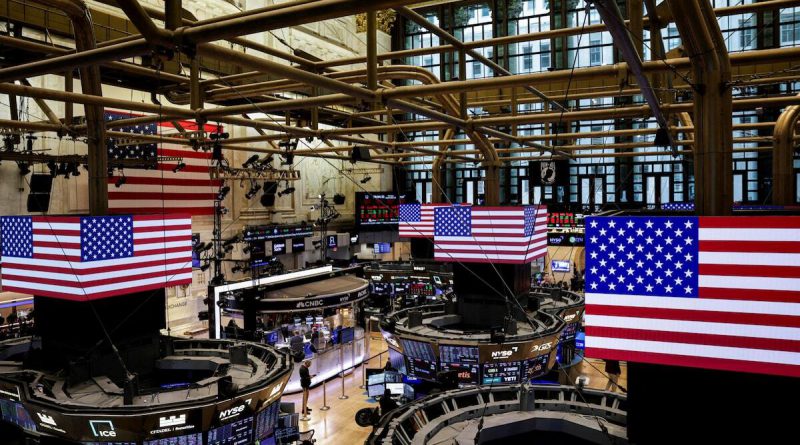Wall Street Rebounds as Powell Hints Fed Balance Sheet Runoff Nearing End
Federal Reserve’s signal sparks investor optimism, driving Dow and S&P 500 into positive territory as markets eye stability and easing liquidity pressures
In a notable turnaround for U.S. financial markets, the Dow Jones Industrial Average and the S&P 500 edged into positive territory on Tuesday following remarks by Federal Reserve Chair Jerome Powell, who indicated that the central bank could soon bring its ongoing balance sheet runoff — often referred to as quantitative tightening — to a close.
The statement sparked optimism among investors that tighter financial conditions may soon ease, providing a fresh tailwind to equities after weeks of volatility.
At 12:27 p.m. ET, the Dow Jones Industrial Average climbed 216.82 points, or 0.47%, to 46,284.03, while the S&P 500 gained 3.08 points, or 0.05%, to 6,657.80.
Meanwhile, the Nasdaq Composite remained under slight pressure, falling 0.34% to 22,617.72, as technology stocks lagged behind broader market gains.
Powell’s Remarks Revive Market Confidence
Powell’s comments came during a financial stability discussion in Washington, where he acknowledged that the Federal Reserve was making progress in normalizing its balance sheet but noted that the central bank was “closer to the end than the beginning” of the runoff.
This move, which involves reducing the Fed’s holdings of Treasuries and mortgage-backed securities, was designed to drain excess liquidity from the financial system following the pandemic-era stimulus.
Markets interpreted Powell’s remarks as a signal that the Federal Reserve may be preparing to adopt a more neutral stance on monetary policy after an extended period of tightening.
The reassurance of potential policy stability boosted investor confidence, particularly among institutional traders who have been cautious amid concerns of higher borrowing costs and slowing corporate earnings.
The optimism rippled through sectors most sensitive to interest rate changes, with financials and industrials leading gains on the S&P 500. Major banks like Citigroup and JPMorgan Chase saw moderate advances as investors priced in a more stable credit environment. The easing of balance sheet runoff expectations could also relieve pressure on liquidity, benefiting the broader banking system.
Industrial stocks, including Boeing and Caterpillar, also gained ground, reflecting growing confidence in continued infrastructure and capital investment trends.
The shift in sentiment suggested that investors were beginning to price in a “soft landing” scenario — where inflation cools without triggering a severe recession.
Tech Stocks Lag Despite Broader Optimism
While the Dow and S&P 500 turned positive, the Nasdaq Composite remained in the red, weighed down by declines in major technology firms such as Broadcom and Nvidia, which saw mild pullbacks after recent rallies. Analysts suggested that investors are rotating out of high-growth tech names into value-oriented and cyclical sectors, anticipating a period of stable but moderate economic growth.
Nevertheless, the longer-term outlook for technology remains strong, with companies continuing to benefit from trends in artificial intelligence, semiconductors, and cloud infrastructure.
“This brief dip in tech could simply be profit-taking,” said one market strategist, adding that the fundamentals of the sector remain intact.
The timing of Powell’s remarks also coincides with the beginning of the third-quarter earnings season, which will see major corporations across finance, technology, and energy sectors report results in the coming weeks. Market participants are optimistic that solid earnings, combined with potentially easing monetary pressures, could provide the next leg of the market’s rally.
“Powell’s tone today was reassuring,” said Sophie Lang, senior economist at Morningcrest Capital.
“Investors have been looking for clarity on liquidity conditions, and his statement signals that the Fed may soon pivot toward balance, rather than further tightening. That alone reduces uncertainty — and markets love certainty.”
While Powell’s comments offered relief, analysts cautioned that the Fed’s next moves will depend heavily on upcoming inflation and employment data. Any resurgence in inflationary pressures could delay the end of the runoff or trigger renewed tightening. Still, the broader consensus appears to be that the worst of liquidity constraints is behind the market.
The Federal Reserve’s dual mandate of promoting maximum employment and stable prices continues to guide its decisions, but with inflation trending lower and economic activity stabilizing, investors see growing room for a more balanced approach.
The Bigger Picture
Tuesday’s modest rally reflects growing optimism across Wall Street that the Federal Reserve’s tightening cycle is nearing completion. With Powell signaling a potential end to the balance sheet drawdown, markets are beginning to envision a period of renewed stability and strategic growth.
As the Dow and S&P 500 moved upward, investors welcomed the possibility of a more predictable financial landscape — one that could restore confidence, encourage lending, and reignite equity momentum heading into the final quarter of 2025.
In essence, Powell’s message has offered something Wall Street craves most — clarity and calm. And in today’s market, that alone is enough to turn cautious sentiment into cautious optimism.



